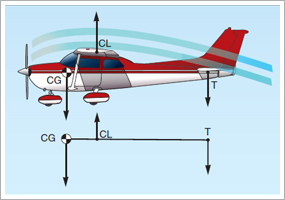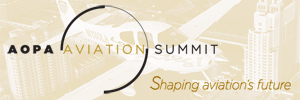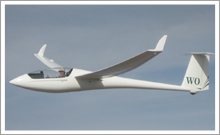| ||||
| | FT News | Inside AOPA | TRAINING PRODUCTS | FINAL EXAM | |||
TRAINING TIPsLongitudinal stability The Oct. 2 Training Tip discussed loading your aircraft to optimize its center of gravity. Don’t just check that the CG is within general limits. A flight to practice stalls or high angle-of-attack maneuvers will be safer, and the aircraft more responsive, with a forward CG. The aerodynamic stability inherent in your aircraft’s design depends on proper loading. Longitudinal stability responds to the position of the CG. What does this mean in practice? “An airplane is designed to have stability that allows it to be trimmed so that it will maintain straight and level flight with hands off the controls. Longitudinal stability is maintained by ensuring that the CG is slightly ahead of the center of lift,” the FAA’s Aircraft Weight and Balance Handbook explains. The CG’s position induces a nose-down tendency, which must be offset by an opposing force to keep the aircraft in aerodynamic balance. That’s where the horizontal tail design comes into play. “It acts behind the center of lift. It uses the fuselage as a lever and pulls the nose up to the desired pitch attitude. The pilot controls the down force, and thereby the airplane's pitch, by manipulating and/or trimming the elevator,” Ed Kolano explained in the December 1996 “ Form and Function.” Sounds good—but wouldn’t it be helpful to see this theory at work? Chapter 3 of the Pilot’s Handbook of Aeronautical Knowledge provides a way: “A simple demonstration of longitudinal stability may be made as follows: Trim the airplane for ‘hands off’ control in level flight. Then momentarily give the controls a slight push to nose the airplane down. If, within a brief period, the nose rises to the original position and then stops, the airplane is statically stable. Ordinarily, the nose will pass the original position (that of level flight) and a series of slow pitching oscillations will follow. If the oscillations gradually cease, the airplane has positive stability; if they continue unevenly, the airplane has neutral stability; if they increase, the airplane is unstable.” Don’t conclude from this that all CG problems stem from rearward loadings. Chapter 8 of the Pilot’s Handbook of Aeronautical Knowledge notes that an excessively forward CG “may result in nose heaviness to the extent that it may be difficult or impossible to flare for landing.” YOUR PARTNER IN TRAININGThe AOPA Medical Certification home page is the starting point for information about medical certification issues. Medical subject reports, answers to common aviation medical concerns, searchable listings of aviation medical examiners and medications the FAA allows or prohibits, and a medical online status request form to assist with your medical certification are also available.
Did you know that student pilots who join AOPA are three times more likely to complete their flight training? Membership includes unlimited access to aviation information by phone (800/USA-AOPA, weekdays from 8:30 a.m. to 6 p.m. Eastern time) or from AOPA Flight Training Online or AOPA Online. If you’re not already a member, join today and get the pilot’s edge. Login information is available online. FLIGHT TRAINING NEWSAirlines facing pilot shortage, flight school leaders sayThere is no doubt that airlines are facing a critical pilot shortage in the short term. That was the message that came out of a meeting this week at Delta Connection Academy in Sanford, Fla., attended by leaders of some of the country’s best flight schools, regional airlines, and financial and regulatory agencies. Capt. Mark Libretto, a pilot with JetBlue and a graduate of Delta Connection Academy, said he believes that airlines must act now to ensure they will be able to hire the caliber of pilots that will be needed. Read more >> King Schools to offer Redbird flight simulatorsKing Schools Inc., the instructional source led by John and Martha King, is offering Redbird Flight Simulations, a newcomer to the flight sim market. King Schools has exclusive marketing, sales, and distribution rights worldwide. The simulators are high-fidelity, full-motion products geared to the general aviation market. Available for less than $67,000, Redbird’s simulator uses student-specific scenarios to allow for maximum flexibility and interactivity in training. “Redbird’s products bring the same level of flight experience to new and non-professional pilots that has proven so effective in creating safe and proficient professional pilots,” said Barry Knuttila, head of marketing and technology for King Schools. Read more >> Cessna releases sport pilot programCessna Aircraft Co. announced last week that it has released its new sport/private pilot course to its Cessna Pilot Center network. The Web-based system allows customers to access training materials from any location with Internet access, and incorporates customizable scenarios for maximum instructor flexibility, the company said. “This new training program, coupled with the anticipated deliveries of Cessna’s new light sport aircraft, the 162 SkyCatcher, later this year, makes this the complete package for anyone who wants to learn to fly,” said Tom Aniello, Cessna’s vice president of marketing. Steer clear of other aircraftMidair collisions, while rare, more often than not occur close to home. More than half of collisions are within five miles of an airport, and 96 percent occur at or below 3,000 feet agl. Get the tools you need to identify potential threats and follow procedures to lessen your risk of an in-flight collision or runway incursion with the AOPA Air Safety Foundation's updated Collision Avoidance Safety Advisor. The Safety Advisor provides strategies for steering clear of other aircraft during critical stages of flight when the risk is highest: traffic pattern operations, descents into congested areas, and maneuvering flight activities. But collision avoidance doesn't just start at takeoff—learn how to scan for aircraft and what to keep in mind on the ground and through every stage of flight. U.S. Airways Flight 1549 pilots to lead Young EaglesCapt. Chesley “Sully” Sullenberger and First Officer Jeffrey Skiles, the U.S. Airways Flight 1549 pilots who made the acclaimed emergency landing on the Hudson River in January, were named co-chairmen of the Experimental Aircraft Association’s Young Eagles Program on Sept. 26. EAA members have given flights in general aviation aircraft to nearly 1.5 million young people through the program since its launch in 1992. Sullenberger and Skiles succeed actor and pilot Harrison Ford, who has served as chairman of the program for five years. Read more >> Sport pilot school unveils new hangar at open houseIn January 2007, Chesapeake Sport Pilot opened for business at Bay Bridge Airport in Stevensville, Md., with a single airplane. Today, CSP has a fleet of seven aircraft, 17 instructors, and 70 students. On Sept. 26, the school’s owners held a ribbon-cutting ceremony and open house to christen a new 6,000-square-foot hangar and office building. “This was not in the plans,” said CSP co-owner Tim Adelman, “but demand for light sport training overwhelmed us.” Read more >> National charting office to get new nameThe National Aeronautical Charting Office (NACO) will be known under a new name on Oct. 11. The FAA will combine NACO and the National Flight Procedures Office into one organization: the National Aeronautical Navigation Services, or “AeroNav Services.” NACO is the agency that publishes and distributes aeronautical charts and other flight information publications. The move to combine the two organizations is part of an effort to streamline charting operations; the plan also includes technological improvements and changes in the way charts are distributed. Read more >> Inside AOPAAerodynamics course provides stall/spin insightThe word "aerodynamics" might conjure images of dry textbooks and dense equations, but a basic understanding of how wings work can help pilots avoid the maneuvering mistakes that cause so many accidents. The AOPA Air Safety Foundation's interactive online course Essential Aerodynamics: Stalls, Spins, and Safety makes the need-to-know concepts of aerodynamics and maneuvering flight easy to grasp. It covers the basics of why airplanes fly, how weight and G forces affect the wing, and why stalls and spins happen (and how to recover from them), among other topics. The free online course runs approximately 60 to 90 minutes, but your progress is saved so you can take a break whenever you like. Hangar talk humorKick back, laugh, and learn how to become a better pilot with aviation humorist Rod Machado at AOPA Aviation Summit, Nov. 5 through 7, in Tampa, Fla. Machado, who has accumulated quirky stories during his decades of teaching people how to fly, will share his insight in “Aviation Humor” on Friday, Nov. 6, from 11 a.m. to noon, in rooms 13, 14, and 15 in the Tampa Convention Center. Machado also is a columnist for AOPA Flight Training. Because of his passion for flight instruction, Machado will dedicate time at Summit specifically to student pilots and those interested in learning to fly. Read more >> AOPA Aircraft Financing program smoothes the buying processThinking of buying an airplane? Ready to upgrade or refinance your existing aircraft? The AOPA Aircraft Financing program, brought to you by Bank of America, is committed to making your purchasing experience as easy as possible. We encourage you to read through the information on our Web site. There are links to frequently asked questions, 10 tips to aircraft financing for first-time buyers, a loan calculator to assist you in figuring out what loan fits into your monthly budget, and financial information needed after applying for your aircraft loan. Best of all, you can apply for your loan online. Once you have submitted your application, an associate will contact you the next business day. If you have any questions after reviewing the information online, call 800/62PLANE (800/627-5263).
TRAINING PRODUCTS‘The Finer Points’ releases iPhone applicationThe Finer Points of Flying and ForeFlight have teamed up to produce a new iPhone application, VFR Communications. The five-chapter instructional course available for the iPhone and iPod Touch features an hour of high-definition video, computer animation, and instruction from CFI Jason Miller. Content includes airspace dimensions, charting, entry requirements, and real-world cockpit footage demonstrating how a proficient pilot communicates efficiently in complex airspace. It’s available as a $29.95 download at Apple’s App Store at iTunes. You may also purchase a DVD version for $49.95 at The Finer Points Web site.
Note: Products listed have not been evaluated by ePilot editors unless otherwise noted. AOPA assumes no responsibility for products or services listed or for claims or actions by manufacturers or vendors. FINAL EXAMQuestion: I have heard that there are phone numbers available for certain weather stations so pilots can get weather conditions at the airport. Is this true, and if so, how do I find these numbers?
Answer: Automated weather information by telephone comes in handy in many situations. Most airports equipped with AWOS or ASOS have a phone-access feature. The phone number can be found in AOPA’s Airport Directory Online or in the FAA’s Airport/Facility Directory. You also can contact a flight service station at 800/WX-BRIEF for additional information or assistance. Got a question for our technical services staff? E-mail [email protected] or call the Pilot Information Center, 800/872-2672. Don’t forget the online archive of "Final Exam" questions and answers, searchable by keyword or topic. Picture Perfect
AVIATION EVENTS & WEATHER To submit an event or to search all events in the calendar, visit AOPA Online. For airport details, including FBO fuel prices, see AOPA’s Airport Directory Online. Flight Instructor Refresher ClinicsThe next AOPA Air Safety Foundation Flight Instructor Refresher Clinics are scheduled in Wichita, Kan., and Corpus Christi, Texas, Oct. 10 and 11; Columbia, S.C., Oct. 17 and 18; Windsor, Conn., Fort Lauderdale, Fla., and Indianapolis, Ind., Oct. 24 and 25; San Diego, Calif., Atlanta, Ga., and Austin, Texas, Nov. 14 and 15; Anchorage, Alaska, Albuquerque, N.M., and Reston, Va., Nov. 21 and 22. For a complete schedule, see AOPA Online.
Can’t make it in person? Sign up for the CFI Refresher Online. AOPA Air Safety Foundation Safety SeminarsAOPA Air Safety Foundation Safety Seminars are scheduled in Poughkeepsie, N.Y., and Madison, Wis., Oct. 12; Colorado Springs, Colo., Cohoes, N.Y., and Milwaukee, Wis., Oct. 13; Northglenn, Colo., Gaithersburg, Md., Liverpool, N.Y, and Manitowoc, Wis., Oct. 14; Rochester, N.Y., Oct. 15; Fairbanks, Alaska, Oct. 16 and 17; Eugene, Ore., Oct. 19; Portland, Ore., Oct. 20; Seattle, Wash., Oct. 21; Palmdale, Calif., Oct. 26; San Luis Obispo, Calif., and Lynchburg, Va., Oct. 27; Fresno, Calif., Oct. 28; and Concord, Calif., Oct. 29. Topics vary—for details and a complete schedule, see AOPA Online. | Got news? Contact ePilot. Having difficulty using this service? Visit the ePilot Frequently Asked Questions now at AOPA Online or write to [email protected]. |
| Member Tools : Send feedback | Update member profile | Change email address | Unsubscribe | ePilot Archive Editorial Team : ePilot Flight Training Editor : Jill Tallman | ePilot Editor: Sarah Brown | Contributor: Alton Marsh |



 Pilots love to take photos, and they love to share them with other pilots. Now you can upload your flying photos to our
Pilots love to take photos, and they love to share them with other pilots. Now you can upload your flying photos to our 

